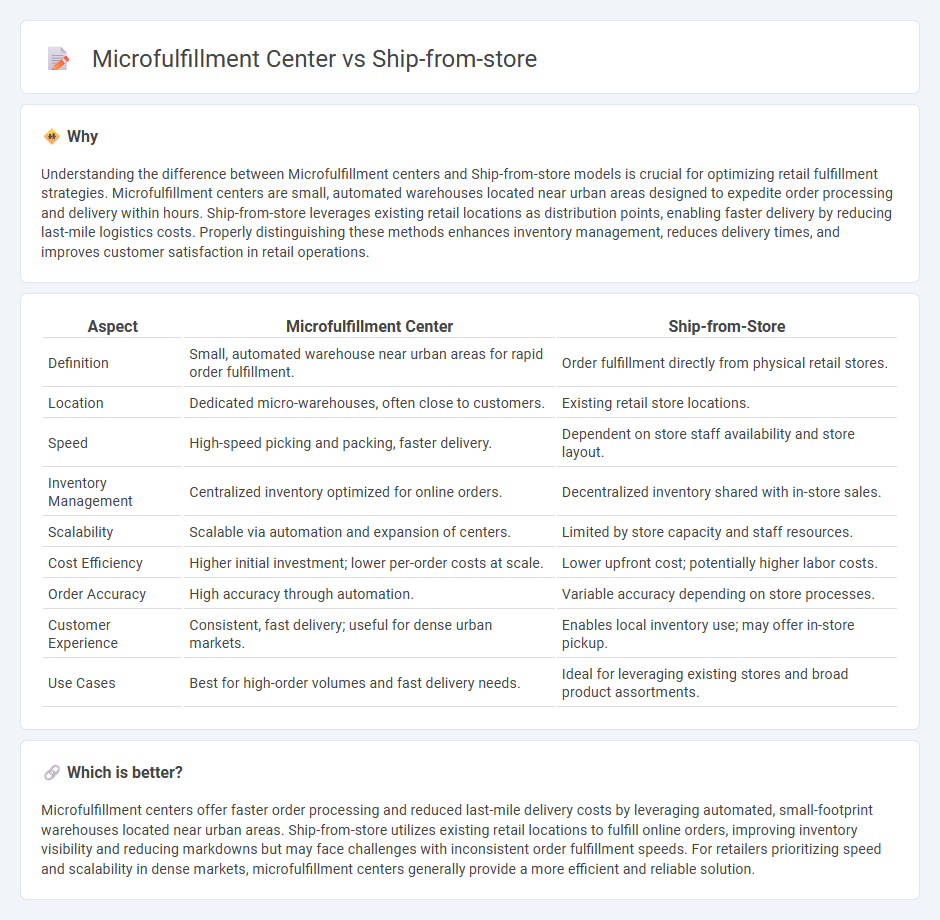
Microfulfillment centers leverage automation and proximity to customers, enabling rapid order fulfillment with reduced delivery times and lower last-mile costs. Ship-from-store utilizes existing retail locations to fulfill online orders, optimizing inventory use and increasing store foot traffic while facing challenges in scalability and operational complexity. Explore the advantages and limitations of each strategy to determine the best fit for your retail business.
Why it is important
Understanding the difference between Microfulfillment centers and Ship-from-store models is crucial for optimizing retail fulfillment strategies. Microfulfillment centers are small, automated warehouses located near urban areas designed to expedite order processing and delivery within hours. Ship-from-store leverages existing retail locations as distribution points, enabling faster delivery by reducing last-mile logistics costs. Properly distinguishing these methods enhances inventory management, reduces delivery times, and improves customer satisfaction in retail operations.
Comparison Table
| Aspect | Microfulfillment Center | Ship-from-Store |
|---|---|---|
| Definition | Small, automated warehouse near urban areas for rapid order fulfillment. | Order fulfillment directly from physical retail stores. |
| Location | Dedicated micro-warehouses, often close to customers. | Existing retail store locations. |
| Speed | High-speed picking and packing, faster delivery. | Dependent on store staff availability and store layout. |
| Inventory Management | Centralized inventory optimized for online orders. | Decentralized inventory shared with in-store sales. |
| Scalability | Scalable via automation and expansion of centers. | Limited by store capacity and staff resources. |
| Cost Efficiency | Higher initial investment; lower per-order costs at scale. | Lower upfront cost; potentially higher labor costs. |
| Order Accuracy | High accuracy through automation. | Variable accuracy depending on store processes. |
| Customer Experience | Consistent, fast delivery; useful for dense urban markets. | Enables local inventory use; may offer in-store pickup. |
| Use Cases | Best for high-order volumes and fast delivery needs. | Ideal for leveraging existing stores and broad product assortments. |
Which is better?
Microfulfillment centers offer faster order processing and reduced last-mile delivery costs by leveraging automated, small-footprint warehouses located near urban areas. Ship-from-store utilizes existing retail locations to fulfill online orders, improving inventory visibility and reducing markdowns but may face challenges with inconsistent order fulfillment speeds. For retailers prioritizing speed and scalability in dense markets, microfulfillment centers generally provide a more efficient and reliable solution.
Connection
Microfulfillment centers enhance retail efficiency by enabling rapid order processing close to customers, while ship-from-store leverages existing brick-and-mortar inventory to fulfill online orders. Both strategies optimize last-mile delivery by reducing shipping times and costs through localized fulfillment. Integrating these systems boosts inventory visibility and enables seamless omnichannel retail experiences.
Key Terms
Inventory Management
Ship-from-store leverages existing retail locations to fulfill online orders, enabling real-time inventory visibility across multiple stores and reducing delivery times. Microfulfillment centers operate as compact, automated warehouses near high-demand areas, optimizing inventory allocation and enhancing order accuracy through advanced robotics and software integration. Explore how these innovative inventory management strategies can transform your retail operations and boost customer satisfaction.
Order Fulfillment Speed
Ship-from-store leverages local retail locations to expedite order fulfillment by reducing last-mile delivery distances, significantly cutting delivery times compared to centralized warehouses. Microfulfillment centers utilize automated systems within urban areas to process orders faster and improve inventory accuracy, enabling same-day or next-day delivery. Explore the differences in speed and efficiency between these fulfillment methods to optimize your retail strategy.
Last-Mile Delivery
Ship-from-store leverages existing retail locations to fulfill orders quickly, reducing delivery distances and enhancing customer satisfaction through faster last-mile delivery. Microfulfillment centers utilize automated, compact facilities situated near urban areas to process high volumes of orders efficiently, cutting transportation times and operational costs. Explore more to understand how each strategy optimizes last-mile delivery for your e-commerce fulfillment.
Source and External Links
Ship From Store: Definition, Operation & Key Benefits - OneStock - Ship From Store is an omnichannel solution allowing online orders to be shipped directly from physical stores using an Order Management System to unify stock and an algorithm to allocate orders to the optimal store, reducing delivery time and cost while combating stock-outs.
What is Ship from Store? Here's What You Should Know - Ship From Store is a fulfillment method where a brick-and-mortar retail store handles online orders by picking, packing, and shipping directly to customers, helping reduce shipping costs and delivery time by shipping from the nearest store location.
What Is Ship From Store? Create Your Strategy (2025) - Shopify - Ship from store refers to fulfilling e-commerce orders from physical retail locations instead of warehouses, allowing faster delivery often within 1-2 business days by leveraging proximity and a point-of-sale system integrated with order management.
 dowidth.com
dowidth.com